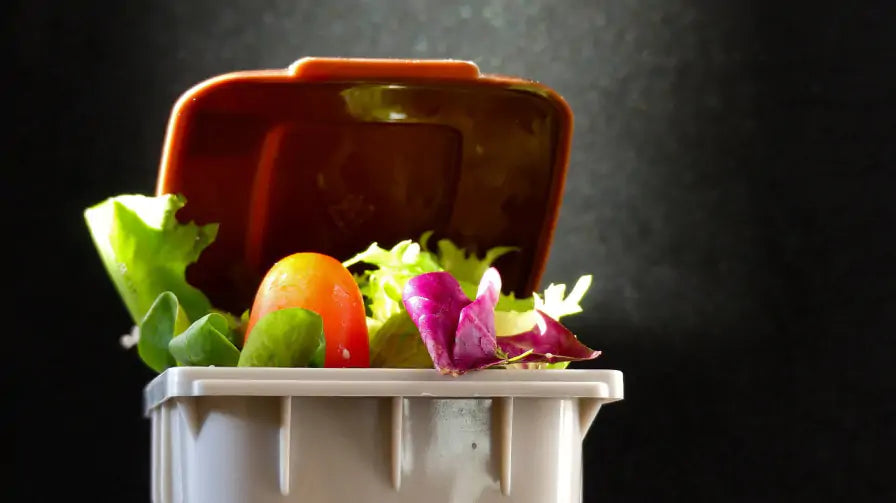Your basket is currently empty.
Shop NowWhat Happens To My Recycled Food Waste?

Have you ever wondered what happens to your recycled food waste once you have put it in your food waste recycling bin? Is it composted? Does it generate green energy? Well, that depends on your local authority and how committed they are to combating global warming and lowering carbon emissions.
Sadly, much of our recycled food waste goes straight to landfill, where it degrades and produces harmful greenhouse gasses such as methane. To overcome this, we need to reduce the amount of food we waste, redistribute edible food to those in need, and turn it into animal feed. But there’s only so much we can do at home.
Here we’ll explain what happens to your recycled food waste, what food producers and manufacturers need to do to help lower this global problem, and what you can do to reduce the amount of food wasted at home.
Food Waste UK – WRAP Facts & Figures
According to a recent report by the Waste and Resources Action Programme (WRAP), we waste 9.5 million tonnes of food in the UK every year. Of that, 4.5 tonnes of that comes from residential households. Our annual food waste, valued at over £19 billion, can generate thirty-six million tonnes of greenhouse gas emissions if not disposed of correctly, causing catastrophic damage to the environment.
The figures are startling. Especially when you consider that over 8.4 million people are struggling to afford to eat in the UK, and much of the food wasted is edible. But what is the answer? According to the government, prevention is better than cure.
Government Waste Hierarchy On Food Waste
It is a legal requirement for businesses in the UK to comply with the food and drink material hierarchy below. But if we are to meet the target set by the UN and halve global food waste by 2030, as a nation, we need to do more.
Here are just some of the things you can do at home to achieve zero food waste:
- Always prepare a shopping list before you buy groceries
- Only buy what you need
- Shop daily rather than weekly if possible
- Do not stockpile. Organise your kitchen so that nothing is left at the back of cupboards to go off or out-of-date
- Master the art of portion control and do not cook more than you need
- Get creative with leftovers and turn them into another meal
- Freeze what you cannot eat, clearly labelling it, so you know how long it has been there
- Make sure your fridge is at the right temperature (between 0-5 degrees) to prolong the shelf-life of your perishables
- Keep an eye on your fruit and veg and use it before it starts to wilt or go off
- Compost food waste at home before putting it in your recycling caddy or bin
By making changes like these, you can significantly lower the volume of food waste produced at home. But you will inevitably generate some waste. If you do not have room for a compost bin, things like eggshells, vegetable peelings, tea bags, and fruit cores should go in your council-issued food recycling receptacle.
What Happens To Food Put In Your Food Recycling Caddy/Bin?
Many local authorities in the UK now collect food waste for recycling into renewable energy or fertiliser. Check with your local council to see what options are available near you. On collection day, your unwanted leftovers are transported to the nearest plant and recycled in one of the following ways:
Turned Into Renewable Energy
Methane gas released by food waste is incredibly damaging to the environment, but it is also a powerful energy source. When processed correctly in an anaerobic digester, it creates biogas that we can use to produce electricity, heat, and transport fuels.
At the anaerobic digestion plant, microorganisms are used to break down food waste into a pulp-like consistency. It is then heated to destroy any harmful bacteria within an enclosed system. As the food breaks down, it releases a mix of methane and carbon dioxide and creates versatile biogas that we can use in many different ways. The leftover pulp produces a nutrient-rich digestate ideal for land regeneration and fertiliser in agricultural settings.
Many councils use this biogas to generate electricity and support the national grid. So it is a win-win solution for everyone and far better for the environment than sending food waste to landfills.
Turned Into Natural Fertiliser
It is also possible to recycle surplus food waste into natural fertiliser in a process called in-vessel composting. This system works much in the same way as home composting. However, it is accelerated through temperatures of up to 70°C to speed up the degradation process and create quality fertiliser in just six weeks. Farmers can use this fertiliser to help grow new crops, developers can use it to create green spaces in urban environments, and it's perfect for rejuvenating topsoil and boosting biodiversity.
Many councils use this option as an eco-friendly option for recyclable food waste, and it sure beats sending it to landfill sites.
Of course, the best solution to the global food waste problem is only buying what we need and eating everything we cook. Carefully planning can make an enormous difference, so take a good look at your kitchen cupboards today. You might have next week’s meals already sitting there, and you could save a fortune on your weekly grocery bills. Make sure you check out the rest of our recycling blog for more helpful tips.

